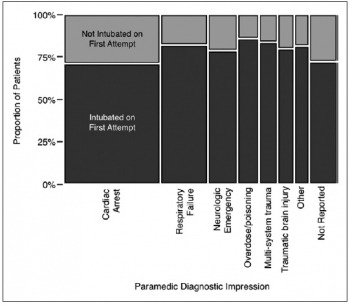20/06/2015
Intubation: L'exemple des paramedic
The process of prehospital airway management: challenges and solutions during paramedic endotracheal intubation
Prekker ME et AL. Crit Care Med. 2014 Jun;42(6):1372-8
------------------------------------------------------
En France les seuls infirmiers à intuber sont les IADE. Pourtant dans le reste du monde d'autres catégories de personnels de santé non médecins le pratiquent. Les EMT communément appelés paramedic sont formés et réalisent ce geste en préhopsitalier. Il existe maintenant suffisamment de littérature pour pouvoir dire que cette pratique est valide avec bien sûr la nécessité d'une formation adaptée. C'est que rapporte ce document qui n'est pas le seul.
------------------------------------------------------
OBJECTIVES:
Endotracheal intubation success rates in the prehospital setting are variable. Our objective was to describe the challenges encountered and corrective actions taken during the process of endotracheal intubation by paramedics.
DESIGN:
Analysis of prehospital airway management using a prospective registry that was linked to an emergency medical services administrative database.
SETTING:
Emergency medical services system serving King County, Washington, 2006-2011. Paramedics in this system have the capability to administer neuromuscular blocking agents to facilitate intubation (i.e., rapid sequence intubation).
PATIENTS:
A total of 7,523 patients more than 12 years old in whom paramedics attempted prehospital endotracheal intubation.
INTERVENTIONS:
None.
MEASUREMENTS AND MAIN RESULTS:
An intubation attempt was defined as the introduction of the laryngoscope into the patient's mouth, and the attempt concluded when the laryngoscope was removed from the mouth. Endotracheal intubation was successful on the first attempt in 77% and ultimately successful in 99% of patients (7,433 of 7,523).

Paramedics used a rapid sequence intubation strategy on 54% of first attempts. Among the subset with a failed first attempt (n = 1,715), bodily fluids obstructing the laryngeal view (50%), obesity (28%), patient positioning (17%), and facial or spinal trauma (6%) were identified as challenges to intubation. A variety of adjustments were made to achieve intubation success, including upper airway suctioning (used in 43% of attempts resulting in success), patient repositioning (38%), rescue bougie use (19%), operator change (16%), and rescue rapid sequence intubation (6%). Surgical cricothyrotomy (0.4%, n = 27) and bag-valve-mask ventilation (0.8%, n = 60) were rarely performed by paramedics as final rescue airway strategies.
CONCLUSIONS:
Airway management in the prehospital setting has substantial challenges. Success can require a collection of adjustments that involve equipment, personnel, and medication often in a simultaneous fashion.
| Tags : intubation, airway

Les commentaires sont fermés.